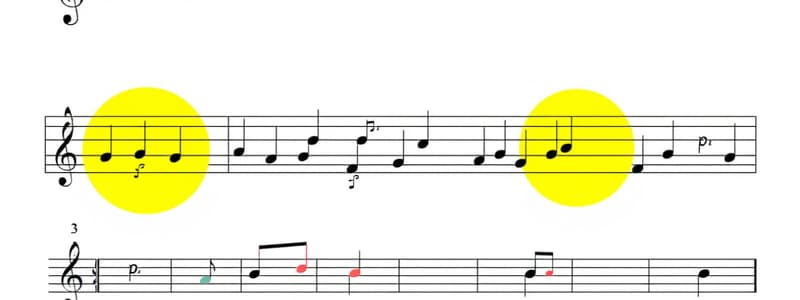Podcast
Questions and Answers
What is a Perfect Authentic Cadence (PAC)?
What is a Perfect Authentic Cadence (PAC)?
- Subdominant to the Tonic 4 to 1
- Ends on the dominant chord
- Dominant to the Tonic 5 to 1 with both chords in root position (correct)
- Creates an expectation of going to I, but substitutes another chord
What is an Imperfect Authentic Cadence (IAC)?
What is an Imperfect Authentic Cadence (IAC)?
V-I or V7-I cadence where either the V chord is not in root position or the final soprano note is not the root.
What defines a Half Cadence (HC)?
What defines a Half Cadence (HC)?
A cadence ending on the dominant (V).
What is a Plagal Cadence (PC) also known as?
What is a Plagal Cadence (PC) also known as?
What characterizes an Inverted IAC?
What characterizes an Inverted IAC?
What is a Leading Tone IAC?
What is a Leading Tone IAC?
What are the three types of Imperfect Authentic Cadences (IAC)?
What are the three types of Imperfect Authentic Cadences (IAC)?
What is a cadence?
What is a cadence?
Study Notes
Types of Musical Cadences
-
Perfect Authentic Cadence (PAC):
- Progression from dominant (V) to tonic (I), characterized by V-I or V7-I
- Both chords must be in root position with the tonic in the highest voice.
-
Imperfect Authentic Cadence (IAC):
- Similar progression as PAC but one of the following conditions applies:
- V chord is not in root position.
- Final soprano note is not the tonic.
- Similar progression as PAC but one of the following conditions applies:
-
Half Cadence (HC):
- Terminates on the dominant chord (V), often approached from various chords such as I, ii, IV, or V/V.
-
Plagal Cadence (PC):
- Moves from subdominant (IV/iv) to tonic (I), commonly referred to as the "Amen Cadence".
-
Deceptive Cadence (DC):
- Dominant chord (V) resolves to a chord other than tonic (I), creating an expectation that is not fulfilled.
- Common substitutes for tonic include vi, IV6, bVI, IV, or V/ii, typically progressing from V to VI.
-
Root Position IAC:
- A type of Imperfect Authentic Cadence where the melody contains the notes 3 or 5 while ending with V-I.
-
Inverted IAC:
- At least one of the chords is inverted in the progression V(7) to I.
-
Leading Tone IAC:
- In this variation, the V chord is substituted with a vii° diminished chord, resulting in a progression of vii° to I.
-
Types of Imperfect Authentic Cadences (IAC):
- Root Position IAC: Ends with a non-tonic highest voice.
- Inverted IAC: Involving one or more inverted chords.
- Leading Tone IAC: Featuring a vii° diminished chord replacing the dominant.
-
Cadence Definition:
- A chord progression marking the ending of a phrase, section, or song, characterized by a rhythmic rise and fall.
Studying That Suits You
Use AI to generate personalized quizzes and flashcards to suit your learning preferences.
Description
Test your knowledge on the different types of musical cadences, including Perfect Authentic, Imperfect Authentic, Half, Plagal, and Deceptive cadences. This quiz will challenge your understanding of chord progressions and their characteristics in music theory.




